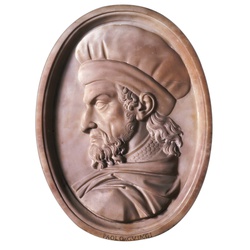Paolo Guinigi
Valle del Serchio. Più vicino a te

The origin of the Guinigi family is so rooted in time that it is held that the founding father of the "Winizio" was the promoter of one of the most prosperous secular curtis of the Garfagnana, the Vallico, recorded starting from 1122. A collection of lands and buildings subject to the control of a sole proprietor, the curtis stood as a new model of land organisation in the High Middle Ages. These vast possessions were held by lords who might belong to the secular aristocracy or the ecclesiastical orders.
As regards Paolo, he was born in Lucca in 1376, to Francesco Guinigi, a skilful merchant and a man of politics of his time, and Filippa di Arbore Serpente, heir to the Castracani inheritance and third wife of Francesco, but since he was not the only son, this was shared among his four brothers (Lazzaro, Roberto, Antonio and Bartolomeo) and ten sisters. To pursue the family’s trade contacts, at little more than thirteen he was sent to join his older brother Lazzaro in London and Bruges, where he learned the art of commerce. Returning home in 1392, he was appointed to important political posts in the state of Lucca and became a member of the Board of Elders.
In 1400, Paolo was elected Captain and Defender of the People, taking on the role of the de facto Lord of Lucca and revealing himself to be a shrewd politician. With a series of well-planned marriages, he succeeded in weaving relations with high-ranking families like the Antelminelli of Lucca, the Del Carretto of Genoa, the Da Varano from Camerino and the Trinci of Foligno.
Paolo Guinigi kept the peace in the Lucchese territory for thirty years, defending the state’s borders with a system of fortifications inherited from the administrations of the past. Having seen the condition of the fortifications, rather battered and ill-equipped, he ordered a vast renovation project, demanding that all the structures be well-guarded and fully equipped. Estensi, Malaspina, Florentines and Pisas, while regarded as “friends”, might turn around at any moment and threaten the hard-won freedom of the state of Lucca. Many of the fortresses and fortified strongholds of Mediavalle and Garfagnana were upgraded at this time.
Paolo Guinigi had a special bond with the mountainous area of Lucca and often left his palaces and took up temporary residence in the tower of the Fortress of Ghivizzano, a building that was renovated for residential use and probably fell into his hand following his first marriage to Maria Caterina Antelminelli, granddaughter and heir of Castruccio Castracani, who died barely eleven years after the wedding.
The diplomatic and prudent foreign policy of Paolo Guinigi allowed the Lord of Lucca to prosper thanks to the trade in silk and marble, but the friendship with Filippo Maria dei Visconti of Milan gave Florence a reason to attack the peaceful state. The soldiers of Niccolò Piccinino besieged the capital, but the siege was broken off on the intervention of Ladislao Guinigi. The situation worsened, however, due to a popular revolt and Paolo was forced to flee, seeking refuge in Milan.
On 15 August 1430, the Republic of Lucca was restored, along with the ancient forms of government removed by Guinigi. Paolo was condemned to death and, for that reason, the Duke of Milan himself had him arrested and thrown into prison in Pavia where, in 1432, after two years’ imprisonment, he died.



